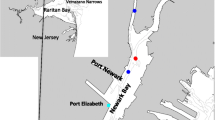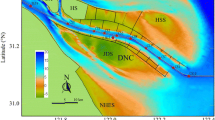Abstract
Measurements of current velocity profiles during and after cresting of the Suwannee River in Northern Florida, USA, were used to investigate the effects of increased river discharge on subtidal flows near the estuarine transition with the Gulf of Mexico. Three moored velocity profilers were deployed across a lower estuary cross-section. The cross-section bathymetry consisted of a channel (∼5.5 m deep) near the western bank of the estuary that shoaled monotonically eastward. Two-layer gravitational exchange developed only in the deepest part of the cross-section during the river cresting and persisted for ∼20 days. After this ∼20-day period, the net flow decreased and was seaward throughout the water column. Net flows outside the channel were seaward throughout the observation period and were modulated by the river pulse. By comparing the estuarine response in the 5.5-m channel to theoretical responses driven by a dynamic balance between pressure gradient and stress divergence, a condition required for two-layered flow was proposed. Gravitational exchange flow should be expected when the ratio of density-driven flow to river-induced flow is greater than 0.23 to 0.28. Smaller values of this ratio should produce unidirectional, seaward flows after a river pulse. Two-layered flows restricted to the channel can be explained also with this ratio because of the sensitivity of density-driven flows to local depth and eddy viscosity. These findings need to be tested against observations in other systems affected by extreme freshwater pulses.








Similar content being viewed by others
References
Abood KA (1974) Circulation in the Hudson River estuary: Hudson River Colloquium. Annal N Y Acad Sci 250:38–111
Bales JD, Tomlinson SA, Tillis G (2006) Flow and salt transport in the Suwannee River estuary, Florida, 1999–2000: Analysis of data and three-dimensional simulations, United States Geological Survey, Professional Paper 1656-B, 66 p
Buschman FA, Hoitink AJF, van der Vegt M, Hoekstra P (2009) Subtidal water level variation controlled by river flow and tides. Water Resour Res 45:W10420. doi:10.1029/2009WR008167
Fischer HB, List EJ, Koh HCY, Imberger J, Brooks NA (1979) Mixing in inland and coastal waters. Acaclemic’Press, Inc., New York, xiv + 483 p
Garvine RW, McCarthy RK, Wong K-C (1992) The axial salinity distribution in the Delaware estuary and its weak response to river discharge. Estuar Coast Shelf Sci 35:157–165
Garza R, Mirti T (2003) Implementation of a river-level forecast site in the Suwannee River basin, Florida. In: Hatcher KJ (ed) Proceedings of the 2003 Georgia Water Resources Conference. University of Georgia, Athens
Geyer WR et al (2000) The dynamics of a partially mixed estuary. J Phys Oceanogr 30:2035–2048
Godin G (1999) The propagation of tides up rivers with special considerations on the upper Saint Lawrence river. Estuar Coast Shelf Sci 48:307–324
Kobayashi S, Zenitani H, Nagamoto K, Futamura A, Fujiwara T (2010) Gravitational circulation and its response to the variation in river discharge in the Seto Inland Sea, Japan. J Geophys Res 115, C03009. doi:10.1029/2007JC004503
Kundu PK (1990) Fluid Mechanics. Academic, New York, 638 p
LeBlond PH (1978) On tidal propagation in shallow rivers. J Geophys Res 83(C9):4717–4721
Li J, Chen Z (1998) Sediment resuspension and implications for turbidity maximum in the Changjiang Estuary. Mar Geol 148:117–124
Light HM, Darst MR, Lewis LJ, Howell DA (2002) Hydrology, vegetation, and soils of riverine and tidal floodplain forests of the lower Suwannee River, Florida, and potential impacts of flow reductions: U.S. Geological Survey Professional Paper 1656-A, 124 p
MacCready P (1999) Estuarine adjustment to changes in river flow and tidal mixing. J Phys Oceanogr 29:708–726
MacCready P (2007) Estuarine adjustment. J Phys Oceanogr 37:2133–2145
Monismith SG, Kimmerer W, Burau JR, Stacey MT (2002) Structure and flow-induced variability of the subtidal salinity field in northern San Francisco Bay. J Phys Oceanogr 32:3003–3018
Officer CB (1976) Physical oceanography of estuaries (and associated coastal waters). Wiley, New York, p 465
Pritchard DW (1956) The dynamic structure of a coastal plain estuary. J Mar Res 15:33–42
Valle-Levinson A, Wong KC, Bosley K (2002) Response of lower Chesapeake Bay to forcing from hurricane Floyd. Cont Shelf Res 22:1715–1729
van Maren DS, Hoekstra P (2004) Seasonal variation of hydrodynamics and sediment dynamics in a shallow subtropical estuary: the Ba Lat River, Vietnam. Estuar Coast Shelf Sci 60:529–540
Verdi RJ (2005) Hydrologic Effects of the 2004 Hurricane Season in Northwest Florida: U.S. Geological Survey Open-File Report 2005–1277, 18 p
Wolanski E, Ngoc Huan N, Spagnol S (1998) Sediment dynamics during low flow conditions in the Mekong River estuary, Vietnam. J Coast Res 14(2):472–482
Acknowledgments
This study was made possible by a US National Science Foundation Rapid Response grant OCE-0938249. The field experience of Vik Adams allowed the successful deployment and retrieval of instruments and is sincerely appreciated. The following people assisted in deployments, retrievals and early data analysis and their contributions are gratefully acknowledged: A. Waterhouse, U. Gravois, J. Marin, D. Gipson, B. Wainright, B. Waite, M. Nelson, B. Basdurak, P. Cheng, J. Lee, and C. Winant. Two anonymous reviewers provided comments that improved this presentation.
Author information
Authors and Affiliations
Corresponding author
Additional information
Responsible Editor: Chari Pattiaratchi
This article is part of the Topical Collection on Physics of Estuaries and Coastal Seas 2010
Rights and permissions
About this article
Cite this article
Valle-Levinson, A. Impact of record flooding of a subtropical river on estuary/ocean exchange. Ocean Dynamics 62, 77–85 (2012). https://doi.org/10.1007/s10236-011-0491-7
Received:
Accepted:
Published:
Issue Date:
DOI: https://doi.org/10.1007/s10236-011-0491-7




